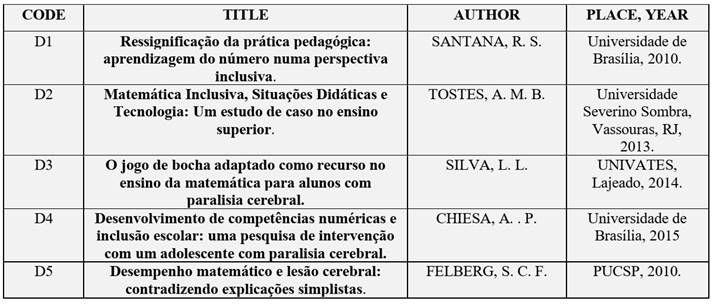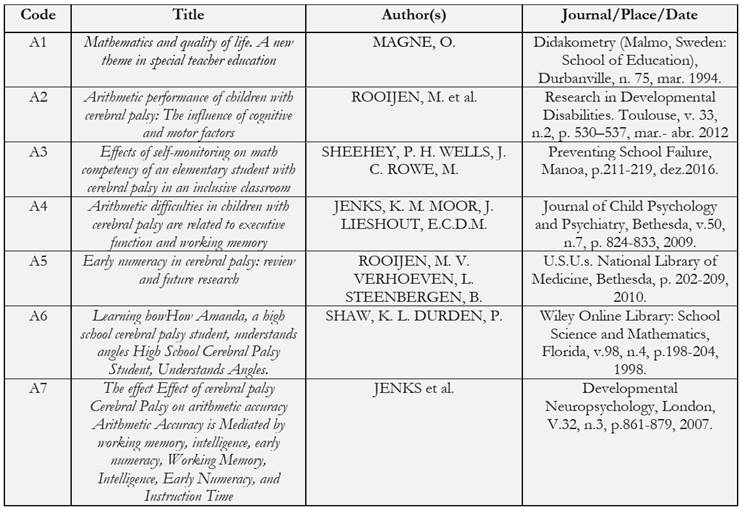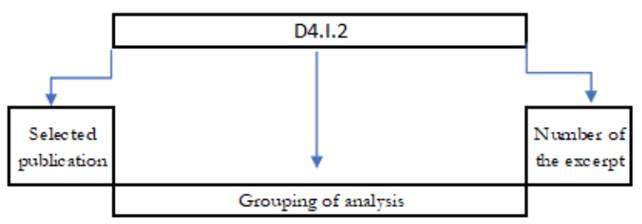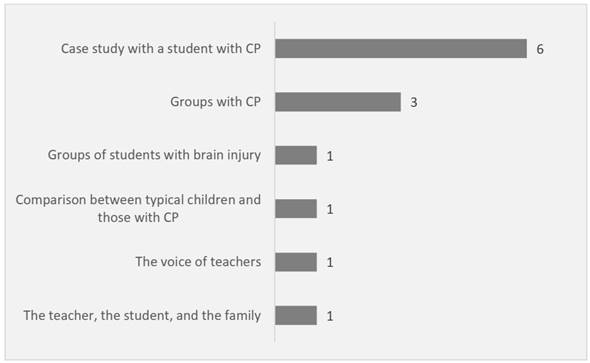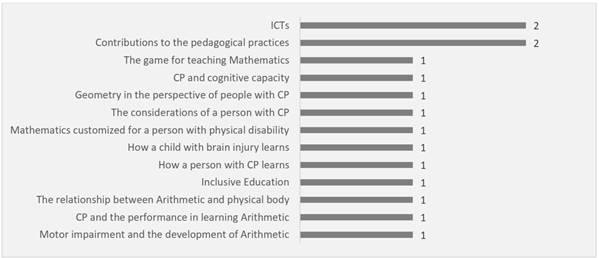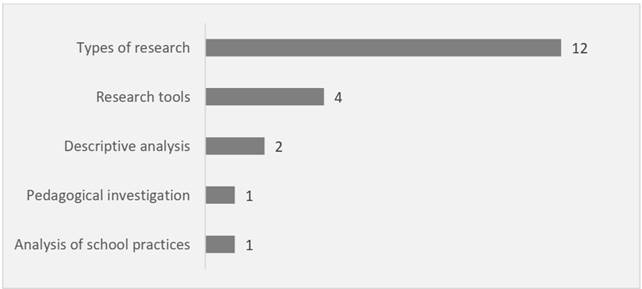Serviços Personalizados
Journal
Artigo
Compartilhar
Educação em Revista
versão impressa ISSN 0102-4698versão On-line ISSN 1982-6621
Educ. rev. vol.36 Belo Horizonte 2020 Epub 26-Maio-2020
https://doi.org/10.1590/0102-4698215616
ARTICLE
PROPOSALS FOR EDUCATION AND TEACHING OF MATHEMATICS FOR STUDENTS WITH CEREBRAL PALSY: A META-ANALYSIS OF SOME ACADEMIC PUBLICATIONS
1Pontifícia Universidade Católica do Rio Grande do Sul. Pelotas, RS, Brasil
This article analyzes studies that articulate Mathematics Education and Teaching for students with cerebral palsy (CP). It aims to identify the main results of researches carried out from 2000 to 2018 and, by a meta-analysis, answer the question: in the publications in the area of education and mathematics teaching aimed at students with cerebral palsy, how is the participation of students, what are the objectives and methodological procedures used, and what are the characteristics of the results achieved? A Discursive Textual Analysis of the publications selected in digital databases shows eight emerging final categories: learning; professional qualification; changes of conceptions; relevance of the theme; technology in teaching; Mathematics and contextualization; individualized proposal; specialized service. This analysis shows that national publications focus on teacher training, while European or American productions are concerned with assessing the student’s cognitive ability, pointing to the need to integrate the two focuses, teacher and student.
Keywords: Mathematics Education; Mathematics Teaching; Cerebral Palsy
Este artigo aborda estudos que articulam Educação e ensino da Matemática para estudantes com paralisia cerebral (PC). Objetiva identificar os principais resultados de pesquisas realizadas no período de 2000 a 2018 e, por meio de uma metanálise, responder à questão: nas produções na área de Educação e de ensino da Matemática voltadas para estudantes com paralisia cerebral, como é explicitada a participação dos estudantes, quais os objetivos e procedimentos metodológicos utilizados e quais as características dos resultados alcançados? Uma Análise Textual Discursiva das produções selecionadas em bases de dados digitais evidencia oito categorias finais emergentes: aprendizagem; formação profissional; mudanças de concepções; relevância do tema; tecnologia no ensino; Matemática e contextualização; proposta individualizada; atendimento especializado. Essa análise mostra que produções nacionais têm foco na formação de professores, enquanto produções europeias ou estadunidenses preocupam-se com a avaliação da capacidade cognitiva do estudante, apontando para a necessidade de integrar os dois focos, professor e estudante.
Palavras-chave: Educação Matemática; Ensino da Matemática; Paralisia Cerebral
Este artículo aborda los estudios que articulan la Educación y la Enseñanza de las Matemáticas a estudiantes con parálisis cerebral. Su objetivo es identificar los principales resultados de la investigación de 2000 a 2018 y, a través de un metanálisis, responder a la pregunta: en las producciones de educación y enseñanza de las matemáticas, dirigidas a estudiantes con parálisis cerebral, cómo es la participación de los estudiantes, cuáles son objetivos metodológicos y procedimientos utilizados y ¿cuáles son las características de los resultados alcanzados? Un análisis textual discursivo de producciones seleccionadas en bases de datos digitales evidencia la aparición de ocho categorías finales: aprendizaje; cualificación profesional; cambios de concepciones; relevancia del tema; tecnología en la enseñanza; Matemáticas y contextualización; propuesta individualizada; servicio especializado Muestra que las producciones nacionales se centran en la formación del profesorado, mientras que las producciones europeas o americanas se preocupan por evaluar la capacidad cognitiva del alumno, señalando la necesidad de integrar los dos enfoques, profesor y alumno.
Palabras clave: Educación matemática; Enseñanza de matemáticas; Parálisis cerebral
FIRST CONSIDERATIONS
The teaching practice developed in Elementary or Higher Education does not require only the theoretical knowledge of an area of specialization, but the understanding of the audience for which one is teaching. This statement appropriates the idea that “[...] the essential message for teachers is that they should pay attention to the continuous process of learning to listen to the student” (POLETTINI, 1999, p. 257-258). For this reason, combining academic knowledge and the understanding of the way the student learns is relevant for teachers to improve their practices, thus allowing the approximation between teacher and student. Therefore, educating, according to Beyer (2006), can be understood as a confrontation with reality when the author states that “[...] teachers who transit daily among their pupils know very well such diversity, [...] for they know they are different from each other, just as there is no human being equal to another” (BEYER, 2006, p. 27). Thus, we emphasize the need to study the differences found in the classroom and the difficulty of teaching a group of students with so many heterogeneities.
Embracing heterogeneity may be one of the required criteria to a fair education for all, without segregating any Other, that is:
[...] In a heterogeneous world, the encounter with the other, with the stranger, with the different, is inevitable. It is a pedagogical and curricular problem. [...] And the problem is this ‘other,’ in a society where identity becomes increasingly diffuse and decentralized. (SILVA; HALL; WOODWARD, 2014, p. 97).
Before this, teaching methodologies must be developed in Mathematics or in any other discipline, and one must understand what the student is learning from a practice that includes everyone, since there is the risk of developing practices for some that end up excluding the others, when the correct is “[...] a school that recognizes equality of learning as a starting point and differences in learning as a process and point of arrival” (MANTOAN; PIETRO; ARANTES, 2006, p. 10). With this reflection, the teacher is taught to understand that everyone must learn, but that each one learns at their own pace. Thus, devoting oneself to a teaching for all, without excluding any student, or to propose a teaching methodology differently for including those who have limitations, is something delicate and that should be considered.
In the context of this proposal, a teaching focused on inclusion considers the physical and learning limitations that students have. In the case of students with cerebral palsy (CP), both their abilities and disabilities should be considered, since, for the World Health Organization (WHO), CP is “[...] a heterogeneous group of non-progressive motor disorders caused by chronic cerebral lesions originated from the prenatal, perinatal, or postnatal periods to the first five years of life” (CASTELLANO; FREIRE, 2014, p. 118). The WHO codifies CP by ICD: G80. According to Cosenza and Guerra (2011), it is possible to understand that not all the functioning of the brain is affected, thus allowing people with CP to develop the same activities developed by other people, but in a different way.
Therefore, this article, which relies on the support of the Coordination for the Improvement of Higher Education Personnel (CAPES), under Code 001, aims to show an analysis of theses, dissertations, articles, or reports of experiences in dealing with events on Education, in the area of Mathematics Education or Teaching, verifying whether the research participants - students with CP and their teachers of Mathematics - are the focus of the studies carried out. As a secondary objective, this article seeks to show the relevance of researches on this topic and which methodological procedures and discussions were created by their conduction. In conclusion, we address convergences or divergences between the researches analyzed, which have a direct relationship with Mathematics Education or Teaching and students with CP.
We use as reference in Mathematics Education the considerations of Garnica (1999, p. 70), who defines Mathematics Education as the “[...] set of social practices developed by specific agents [...],” allowing clarification to be presented from the practice.
For the conception of Mathematics teaching, Fiorentini (2013) highlights the difficulty of defining a way of teaching without being supported in a clear definition about: learning; teaching; Mathematics; Education. Thus, if teachers imagine Mathematics as “[...] logically organized and a-historical or ready and finished, they will certainly have a different pedagogical practice than the ones who conceive it as a living, dynamic science [...] that meets certain social interests and needs” (FIORENTINI, 2013, p. 4). Therefore, for this discussion, we embrace the idea that the teaching of Mathematics is related to methods and ways of teaching that positively contribute to the student’s learning.
To analyze the data found, the meta-analysis method is used, which, according to Castro (2001, p. 1), “[...] is the statistical method used in the systematic review to integrate the results of the completed studies.” Researches of this type are, for Lima et al. (2018), essential when researchers have the need to understand questions that have already been studied, but for which insufficient answers were given, allowing a deepening of the dimension addressed.
The benchmarks that structure a meta-analysis, according to Lima et al. (2018), include: the formulation of the question to be answered; the researched sources; the criteria for selecting the materials found; the evaluation of the publications found; the analysis; and the organization of the data obtained.
The guiding question is: in the productions in the field of Mathematics Education or Teaching aimed at students with CP, how is the participation of students, what are the objectives and methodological procedures used, and what are the characteristics of the results achieved?
This meta-analysis consulted collections of academic studies - dissertations, thesis, and articles - published in the following virtual environments: Acervo Digital da Coordenação de Aperfeiçoamento de Pessoal em Nível Superior (BTDC); Biblioteca Digital Brasileira de Teses e Dissertações (BDTD); Scientific Electronic Library Online (SCIELO); and Institute of Education Sciences (ERIC). In addition, we reviewed publications of reports of scientific experiences or communications in Mathematics Education events of national and international size, such as: Encontro Nacional de Educação Matemática (ENEM), Congreso Iberoamericado de Educación Matemática (CIBEM), and Delta Conference of Teaching and Learning of Undergraduate Mathematics and Statistics (DELTA). These events were chosen by their relevance in the academic environment, considering that, due to their recognition, they could contain recent studies closely related to the theme proposed here. The period covered depended on the selected database. For the events, the search was carried out in the last two editions, considering that they occur biennially [DELTA]; every four years [CIBEM]; or every three years [ENEM]. The period from 2000 to 2018 was defined, considering that it would be enough to obtain current data on the researched theme. However, this filter was only applied after performing the search on each base, as a last resource if there were too many publication found. To this end, the filter that selected studies from the past 10 years was used only in the databases SCIELO, BDTC, and BTDC.
Inclusion criteria were: dissertations, theses, articles, or reports of experience whose proposal involved Mathematics Education or Teaching for people with CP. Publications outside this scope were discarded.
The main descriptors used in the search process, which led to the finding of the publications, were previously chosen in the databases by analyzing the keywords used by the authors. They are: cerebral palsy, Mathematics Education, Mathematics Teaching, Mathematics. It should be noted that, depending on the database investigated, the way of organizing the descriptors differs1 . For instance, in BDTD and BTDC, descriptors cannot be enclosed in parentheses or quotation marks. It is recommended to use hyphen for whole sentences and hyphen, after space, for deletions. One command used is AND, when one wants a term, and the other is OR, for one term or the other, all uppercase.
In Google Scholar, the descriptors are enclosed in quotation marks, and the search is for words that are grouped in that order. Alternatively, in Google Scholar, the words are enclosed in parentheses with the OR command between them. For example, if one writes mathematics (cerebral OR palsy) in the search bar, publications that contain the topics mathematical and cerebral and mathematics and palsy will be searched. For ERIC and SCIELO databases or platforms related to events, the descriptors can be enclosed in quotation marks or separated by the positive mathematical sign (+).
Once the publications were selected for data analysis and organized in reading records composed by code, keywords, objectives, description with authors and methodology, and conclusions, we used as inspiration the Discursive Textual Analysis (DTA) proposed by Moraes and Galiazzi (2014). During the analysis, four topics were considered to structure, from the excerpts, the units of meaning and the categories. In the section referring to the analysis, the initial categories, presented through the text in italics, and the final categories, underlined, emerge by the interpretation of the excerpts highlighted. The categories considered the words judged as more relevant and that highlighted, through the titles, the most important points emphasized by the researchers when describing their studies.
Thus, this article proposes an analysis subdivided into four themes, which address the guiding question for this meta-analysis. The themes were: I. Context of the research, structured from 13 excerpts, giving rise to five final categories, namely: CP-Protagonist (62 ); Group of CP-Protagonists (4); Protagonist children (1); Protagonist teacher (1); and The teacher, the student, and the family (1). II. Study objectives, structured from 15 excerpts, which gave rise to seven final categories thus titled: Teacher training (2); Arithmetic capacity (3); Ideas for inclusion (3); Mathematics for life (1); People with CP and their perspective (2); CP and cognitive capacity (1); Resources for teaching Mathematics (3). III. Theoretical or methodological descriptions, structured from 26 excerpts, giving rise to two final categories: The method (14) and The analysis (12). IV. Main results, structured from 26 excerpts, which gave rise to eight final categories, namely: Vocational training (4); Relevance of the theme (3); Learning (11); Specialized care (1); Mathematics and contextualization (2); Technology in teaching (2); Individualized proposal (1); and Changes in ideas (3).
After these considerations, we present the four sections that structure this text. The first one includes the search processes, the selection criteria, and the publications found. The descriptors used are in italics and written according to the researched base. The second section is dedicated to the systematization of the analysis carried out and aims to address the proposed question. The third section describes the possible convergences or divergences between the authors of the selected researches, and the last section presents some considerations about the analyses conducted in these researches.
DATA COLLECTION
For the collection that provided the analysis of the studies, searches were conducted in eight databases. Two of the databases chosen were BDTD and BTDC, because they have an expressive number of publications carried out in Brazilian graduate courses. Other bases, such as SCIELO and Google Scholar, were chosen because they present journals, theses, and dissertations produced nationally and internationally.
The ERIC database was chosen because it contains academic studies in the field of Education with internationally recognized quality. Last but not least, three events were selected, in Portuguese (ENEM), Spanish (CIBEM), and English (DELTA). The choice of events was due to the fact that these databases contain reports of experiences or researches still being conducted, with their results not yet published in journals or in the repositories of theses and dissertations as the ones mentioned above. For reasons of time limitation, publications were not searched in other databases.
Table 1 shows the descriptors inserted in each search, the number of publications found before and after the filter, and which ones were selected for the analysis, being D1, D2, etc. the codes used for the selected dissertations.
TABLE 1: Description of the searches conducted in each database
| Number of Articles (A), Dissertations (D), or Theses (T) found | ||||
|---|---|---|---|---|
| Databases | Descriptors used | during the search | After filter | Selected |
| BTDC | 1 st search: cerebral-paralyzed | 7,323 | 20 | D1, D2, D3 |
| 2 nd search: cerebral-palsy | 7,143 | 27 | D3 | |
| 3 rd search: cerebral-paralyzed AND mathematics AND teaching AND education | 18 | 18 | D4, D5 | |
| BDTC | 1 st search: mathematics-cerebral-palsy | 1 | 1 | D3 |
| 2nd search: mathematics AND cerebral-palsy | 1 | 1 | D3 | |
| 3rd search: mathematics AND cerebral AND palsy | 330 | 65 | ___ | |
| SCIELO | 1 st search: Cerebral palsy | 385 | 40 | ___ |
| 2 nd search: Mathemathics AND cerebral palsy | ___ | ___ | ___ | |
| GOOGLE SCHOLAR | 1 st search: mathematics (cerebral OR palsy) | 1 | 1 | D3 |
| 2nd search: (teaching OR mathematics) (cerebral OR palsy) | 5 | 5 | D3 | |
| 3 rd search: (education OR mathematics) (cerebral OR palsy) | 68 | 68 | D3 | |
| 4 th search: Mathematics (cerebral AND palsy) | 7 | 7 | ___ | |
| ERIC | 1 st search: cerebral palsy and mathematics | 24 | 24 | A1, A2, A3, A4, A5, A6 |
| ENEM | 1 st search: cerebral palsy, inclusion | ___ | ___ | ___ |
| CIBEM | 1 st search: cerebral palsy, inclusion | 1 | 1 | ___ |
| DELTA | 1 st search: Cerebral palsy, Inclusion Math, Inclusion, Disabled Person, Handicapped | ___ | ___ | ___ |
SOURCE: Prepared by the authors.
In databases such as BDTD and BTDC we had to filter publications, due to their high number. This filter comprised, in the fields of knowledge, the option for the the Humanities or Multidisciplinary area. In the area of knowledge, we chose: Education; Special Education; Teaching; Science and Mathematics Teaching; Teaching-Learning. Still in the search, in the filter applied for the area of evaluation, we chose: Education; and teaching. And the concentration area was: Special individual education; Education; Mathematics Education; Science and Mathematics Teaching. After the filter, publications that belonged to special education areas were excluded, more specifically in the following themes: language; information technologies; literacy; teacher training; family inclusion; neuroscience and intervention with dogs for the development of people with CP; special care and Physics teaching; medicine; Neuro-Education; and technological resources. Chart 1 shows the selected dissertations in BTDC for further analysis.
The search conducted in the SCIELO database returned articles or review articles in the following journals: Revista Brasileira de Educação Especial; Revista Portuguesa de Ciências e Desporto; Educar em Revista; Paidéia (Ribeirão Preto); Anais da Academia Brasileira de Ciências; Cadernos de Pesquisa; Educação e Pesquisa; Educação em Revista; Paradigma. The selected thematic areas were: Humanities and Multidisciplinary. The called Thematic Areas were: Education and Educational Research; Special Education. We found 40 articles, which, after being analyzed according to the our criteria, were excluded because they were not in agreement with them. Graph 1shows the area to which these articles belonged.
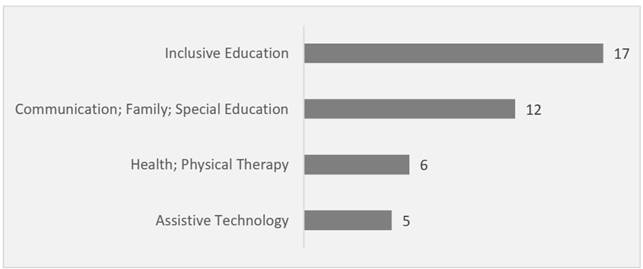
SOURCE: Prepared by the authors.
GRAPH 1: Thematic areas of the 40 articles found in SCIELO after filter of the 1st search
In Google Scholar, after the filter, out of the 68 publications found, as Graph 2 shows, only one dissertation was selected, because the other publications were articles or course completion studies that addressed topics of inclusion, without any relation to Mathematics, thus not meeting the selection criteria proposed in this meta-analysis.
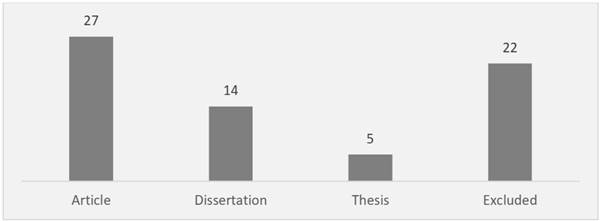
SOURCE: Prepared by the authors.
GRAPH 2: Google Scholar - Types of publications found in the third search
Therefore, when reading the publications found, those that did not have any allusion to Mathematics in their abstract were discarded, since they addressed researches in the areas of public policy, medicine, among others. The others were within the period from 2005 to 2018. However, curiously, a dissertation dating back to 1891 was found, from the city of Porto, in the medical area. For the analysis, we highlight once again the dissertation already codified as D3, found in the first database.
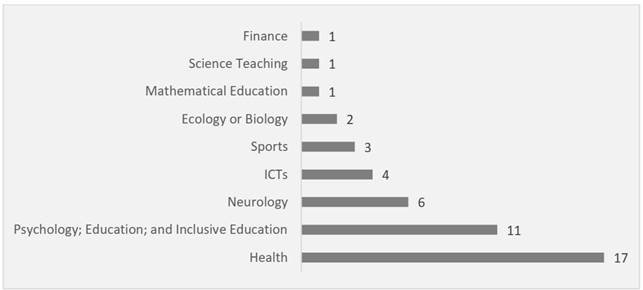
SOURCE: Prepared by the authors.
GRAPH 3: Areas of concentration of the selected productions for the analysis in the 3rd search in Google Scholar
The last search conducted in Google Scholar returned seven publications, two in English and the others in Portuguese. These publications were excluded because they did not address the area of Mathematics Education or Teaching for students with CP.
In the ERIC database, a search by journals was performed. In the filter used in the platform, the following descriptors were chosen: Special Education; Cerebral Palsy. After the filter, 24 articles remained, dated from 1967 to 2017. During the reading, six articles were selected for analysis. Of the excluded articles, three were conference proceedings; two addressed motor capacity studies; four approached technology in teaching; and nine mentioned Mathematics as a research instrument, that is, they did not directly address Mathematics Teaching or Education, but were observations that, through Mathematics, provided results for topics related to: learning capacity, reasoning capacity, reading and interpretation, etc.
It is worth noting that, to read the articles, it was necessary to contact the authors directly, except the first article, which could be downloaded. In this contact, the author of the fourth selected article sent another article that, according to the theme, assisted in the proposed analysis, thus originating the seventh article selected. No other searches were performed in this databases because it was understood that the material found was already sufficient and by the fact that, in the other databases, even though the descriptors varied, the searches ended up finding the same publications.
The searches performed in events such as ENEM, CIBEM, and DELTA had as criteria selecting scientific reports or communications that addressed the theme proposed for this meta-analysis. For the searches made in ENEM, the articles published in the proceedings of the 2013 and 2016 editions, which took place respectively in Curitiba/PR and São Paulo/SP, were mapped. For these bases, the studies described in the articles found were aimed at students whose limitations are deafness or blindness, and the reports focused on teacher education. For this reason, they were excluded.
For the analysis of the articles available in the CIBEM database, the searches were conducted in the proceedings of the VII CIBEM, held in Montevideo, Uruguay, in 2013, and VIII CIBEM, held in Madrid, Spain, in 2017. For the previous editions of this event, the conference proceedings are not available, making it impossible to search them digitally. During the search, using the same keywords as ENEM, we found studies addressing Mathematics aimed at students with deafness and blindness or researches focused on teacher education. In this database, the only study focusing on Mathematics teaching for students with CP is an experience report of 2017 authored by the first author of this meta-analysis. The rereading showed that the report was not a research, but a reflection on the practices to be developed through the author’s experiences. For this reason, it was excluded.
In the last highlighted event, DELTA, which took place in 2013 in the city of Kiama (Australia), in 2015 in the city of Port Elizabeth (South Africa), and in 2017 in the city of Gramado (Brazil), we did not find articles addressing studies with CP in the teaching of Mathematics.
THE SYSTEMATIZATION AND THE PROCESS FOR ANALYSIS
After selecting the dissertations and the articles described above, reading records were created, which, according to Moraes and Galiazzi (2014), help to compose the metatext. This composition is generated from the disassembly of the original texts, giving rise, through the interpretation given by the author of the analysis, to the relationship between the theoretical framework used and the excerpts. During the analysis, the excerpts extracted from the charts gave rise to resignifications, units of meaning, and initial and final categories.
To build the analysis process, the text is organized into four themes: Theme I − Context of the researches, which aims to highlight the importance given to participants, seeking to show whether they were protagonists in the investigation process − only people with CP, teachers of students with CP, or both; Theme II − Study objectives, whose analysis is done in the objective of each publication analyzed; Theme III − Theoretical or methodological descriptions, whose objective is to highlight the paths chosen by the researchers to structure their studies; Theme IV − Main results, which aims to show the conclusions of the studies and subsequently establish convergence and divergence criteria, if any. As a way of coding, the excerpts are presented according to the following figure.
The codeshown in Figure 1 can be read as follows: Excerpt 2 of Theme I of Dissertation 4.
Theme I − Context of the researches
The objective of analyzing the selected publications and seeking the context of the research is to highlight the importance given to participants. It is about knowing which role the participants, be they students with CP or their teachers, have in these studies and whether, through this grouping teachers and students participated in an equitable way, contributing with their experiences for the development of the research.
Regarding the origin of the authors of the dissertations, they are all Brazilians. The authors of the articles, in turn, are from: United States (A1; A3 A6); Netherlands (A2; A5); and Amsterdam (A4; A7). Although the author of article A7 is from Amsterdam, its publication was held in London.
During the analysis process, in this grouping, 13 excerpts identified the context of the selected researches, with the initial purpose of verifying the participation of students with CP and teachers as protagonists in these studies. In reading the excerpts, six initial categories emerged. Graph 4shows these categories and their frequencies.
Of the initial categories listed in Graph 4, the highest frequency occurs in Case study with a student with CP. These researches were conducted in the classroom or in medical institutes, giving prominence only to one individual with CP, as can be seen in excerpt D1.I.1: “[...] case study of a student with mixed CP, included in a regular teaching class.” This initial category is present in the first four dissertations and in articles A3 and A6.
The graph shows that the second most prominent initial category addressed groups of children with CP, as can be seen in excerpt A4.I.1: “The present study represents the culmination of a longitudinal project examining arithmetic difficulties in children with CP, addressing the first three grades of elementary education.” This category appears in articles A2, A4, and A5.
The other categories, all with the same frequency, show the occurrence of comparative studies between children who have CP and others who do not have any brain injury, as found in article A7. In only one of the studies, A1, interviews were conducted with teachers to analyze their practices. In dissertation D1, teachers, students with CP, and their families were included as participants. In dissertation D5, the research context included a group of students who had not only CP, but any other type of brain injury. According to the researcher: “This study included five children and adolescents aged between 12 and 15 years, diagnosed with brain injury of different etiologies (agenesis of the corpus callosum, cerebral palsy with right hemiparesis, stroke) [...]” (D5.I.1). Due to these considerations, it is worth noting that CP is defined, according to Rotta (2002, p. 48), “[...] as a sequel to a brain aggression, which is characterized primarily by a persistent, but not invariable, disorder of tone, posture, and movement [...]”, allowing cognitive development, a fact that is disassociated from motor impairment.
Regarding education level, studies conducted with and for students with CP at higher education were found in only one of the dissertations, which explains: “This is a research conducted in a higher education course in Administration, with a student with CP” (D2.I.1). The other studies are aimed at elementary education, and most are in the initial grades, presenting the concern of “[...] defending the need to study the peculiarities of the development of a student with cerebral palsy to build knowledge [...]” (D4.I.1).
Concerning high school, an article about a case study was found. The article states: “This is a case study used to better understand how a student, Amanda, perceived angles [...]” (A6.I.1). The excerpt shows that article A6 differs from the others regarding the mathematical content approached, since almost all the analyzed studies refer to the perception of students with CP in the field of Arithmetic, not Geometry. In addition, this article deals with the perception of a 16-year-old girl in high school.
By combining the initial categories, the final categories emerge, presented in Graph 5.
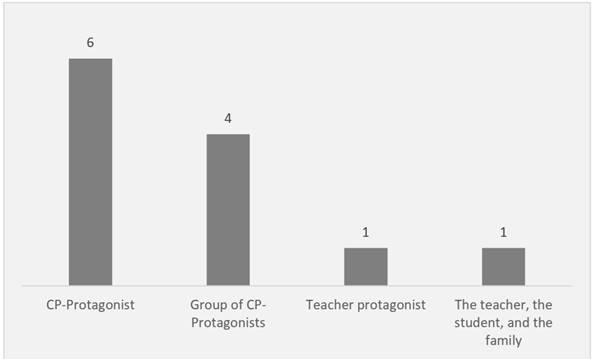
SOURCE: Prepared by the authors.
GRAPH 5: Final categories referring to the context of the researches
Most of the analyzed publications include the student with CP as the protagonist of their studies. The participation of teachers took place in only one of the publications (A1), as well as the participation of children with or without CP or groups formed by several participants, such as teachers, students, and family.
Thus, part of the question proposed in this article - which aims to know whether, in researches directed to this area, the manifestation of students with CP, their teachers, or both is allowed - can be answered by analyzing the context of the selected publications. As presented, there is a scarcity of studies in which both participants - teachers or students with CP - of this type of research participate equally with their experiences, opinions, and perspectives, thus allowing them to manifest themselves to meet the objectives proposed by the authors of the researches.
Considering the extent of the question proposed for this meta-analysis, the following sections show the characteristics of these studies regarding objectives, methodologies, and main results, understanding that an explanation on the theme is a positive contribution for future research proposals.
Theme II − Study objectives
Regarding the objectives of each study analyzed, 15 excerpts were significant for the categories. The objectives of each study have their peculiarities and, for this reason, of the 15 excerpts analyzed, only 13 initial categories were created, as presented in Graph 6and described in italics throughout the paragraphs of this section.
On researches that have as objective Contributions to the pedagogical practices, the authors of dissertations D2 and D4 show how developing activities in this respect contributes to changing conceptions, either from school or the teacher. Dissertation D2, for example, highlights the contribution “[...] to teaching practices, as it presents strategies that make learning Mathematics easier for these students with cerebral palsy” (D2.II.1). These contributions help to understand the school’s role in the students’ education, that is: “The school should no longer be ‘a place,’ but instead be a manifestation of life in all its complexity, in all its network of relationships, showing an institutional way of knowing and wanting to be” (IMBERNÓN, 2000, p. 103). For this reason, the development or improvement of teaching practices should consider everyday situations and constantly seek for strategies to deal with atypical situations. Some teachers who took part in the selected researches argued that, in their education, they had never been trained to teach in regular classes that had students with CP.
Thus, the author of the dissertation that aims to “understand how the teaching of Mathematics in the perspective of Inclusive Education takes place in the school context [...]” (D1.II.1) shows the importance of Inclusive Education, allowing one to appropriate the idea that the “challenge [of] the inclusive school is, precisely, to develop a pedagogy focused on the student, a pedagogy capable of successfully educating all its students, including those with severe disabilities and disadvantages” (HOFFMANN; TAFNER; FICHER, 2003, p. 14). For this reason, studies aimed at students with CP, as well as at students with other special features, should consider the fact that not only the teachers, but also the educational institutions, must rethink their practices.
Thus, the considerations made about the change of posture of teaching institutions and teachers regarding the way of teaching Mathematics for students with CP permeate the understanding of how these students learn. The way a person with CP learns makes “[...] the development process of mathematical conceptual competencies of a student with cerebral palsy, by a psychopedagogical intervention research” (A3.II.1) a researchable topic. This research considers how a child with brain injury learns and aims to “investigate [how] the neuropsychological functioning profile of children and young people diagnosed with brain injury is [...]” (D5.II.1). These considerations highlight the fact that a student with CP has the same cognitive development as any other typical student, and can be equaled, in some cases, to those who do not have brain injury.
For some authors of the articles and dissertations analyzed, the erroneous view that students with CP do not have the ability to learn hinders the development of pedagogical actions that provide the teaching of Mathematics to these students. Thus, a “[...] negative view hinders pedagogical action by not believing that the student with cerebral palsy, especially the one with severe impairment, [...] can develop and learn along with the other students” (MELO; MARTINS, 2004, p. 81). On this, the author of article A3 contributes with what he calls “self-monitoring,” including in the structure of his proposal the considerations of a person with CP about the practices developed in a regular school.
Regarding CP and cognitive capacity, data found in article A7 show that children with CP may have delayed arithmetic ability and delayed verbal and non-verbal intelligence, because “[...] learning also depends on the seriousness of the gross motor impairment [...]” (A2.II.1), reflecting on the motor impairment and the development of Arithmetic. The authors state that not having motor coordination compromises basic functions, such as finger-counting.
Moreover, the relationship between Arithmetic and the physical body is present in the objectives of article A5, which says that “[...] the mind must be understood in the context of its relationship with a physical body that interacts with the world” (A5.II.1). These considerations allow studies that praise CP and the performance in Arithmetic learning at any stage of elementary education, as the authors of article A4 highlight when developing a direct intervention study with students with CP during the first three years of school.
Thus, proposing studies with the objectives listed so far requires researches that analyze strategies for a Mathematics teaching that is satisfactory for all students, including those with CP. For this reason, the Mathematics customized to a person with physical disabilities must consider the “[...] group discussion by teachers in training [...]” (A1.II.1), as well as an “[...] appropriate mathematical content for students with disabilities and the necessary training of special education teachers” (A1.II.1). This customized Mathematics goes toward an inclusive school that proposes “[...] a more meaningful and motivating learning context, arousing more collaborative efforts than the traditional segregation experienced by these students” (MANTOAN, 1997, p. 69).
Concerning the strategies to be developed, one of the proposals could be the development of a teaching practice of Geometry in the perspective of a person with CP. These practices, according to a teacher’s considerations, allow us to understand how much the student “[...] also wanted to better understand how she was learning geometry and how she could use technology in learning [...]” (A6.II.1). In addition, ICTs offer resources for the development of assistive technology, which, according to D2, is aimed at students with motor impairments and shows “how the use of computational tools can enable mathematical learning [...]” (D2.II.3). In addition to computerized resources, technology can be observed in games for the teaching of Mathematics, resource that “[...] can assist in the meaningful learning of mathematical content by students with cerebral palsy [...]” (D3.II.1). These contributions may allow the understanding that, if teachers are able to evaluate their practices and create teaching strategies when faced with students with these characteristics, learning Mathematics becomes much more effective, considering the role of Education, which, according to D’Ambrosio (1997), leads “[...] each individual to develop their creative potential [...]” (p. 70), thus allowing everyone to perform the proposed activities and respecting the learning and abstraction capacity of each person.
The initial categories show that most of the objectives converge to the relationship between motor impairment, cognitive capacity, learning and, as it could not be different, the fact that these students have CP. Graph 7 shows the seven final categories emerging from the approximation of the initial categories.
By analyzing Graph 7, although the objectives of each study have different perspectives, one can conclude that the researchers’ idea is to offer teachers a final product compatible with the possibility of understanding the capacity in Arithmetic and with the fact that students with CP have a satisfactory cognitive development. Therefore, ideas regarding an inclusive school and the need for teachers to rethink their practices are present in the objectives of most of the researches analyzed. For this reason, these studies contribute to the continuity of the education of these teachers and to the creation of teaching proposals that use assistive technology, varied resources such as the development of games, and to the understanding that the most satisfactory solution for all is the presentation of a teaching proposal that shows Mathematics in contexts easily understood by students.
Theme III − Theoretical or methodological descriptions
The objective of analyzing the form chosen by the authors to structure their studies is to know which procedures were used to develop the aforementioned researches, as well as the strategies for analyzing the collected data. The analysis of 20 excerpts gave rise to five initial categories, described in Graph 8.
The initial categories address the research instruments used by the studies or the methods adopted to create the appropriate proposals. A method is understood as a “[...] way of thinking to reach the nature of a certain problem, whether to study it or explain it” (OLIVEIRA, 1999, p. 57). The methodology “[...] consists of studying and evaluating the several methods available, identifying their limitations or not in the context of the implications of their applications” (COSTA; COSTA, 2001, p. 4). For this reason, this section analyzes the methodological procedures used in the selected publications, considering the instruments used.
The initial category, Descriptive analysis, refers to the way the material collected by the researchers was analyzed, so that hypotheses could be established afterwards. Most of the studies analyzed allowed their authors to show preference for recording their activities in writing, as mentioned in D1.III.3: “All activities developed during the research were registered in the field notebook and recorded in audio and/or video.”
However, other studies analyzed applied tests, semi-structured interviews or used scales as a way to analyze the behavior of participants, thus generating the initial category Research instruments. For the authors of article A4, data collection relied on “[...] the application of tests in five sessions, which assess working memory capacity and measure the responsiveness of these students [...]” (A4.III.2). Thus, it is possible to perceive some types of resources or tools used by the researchers to make the necessary analyses of their proposals.
Another initial category, called Types of research, emerges to create a panorama of the theory applied to develop the analyzed proposals. It is noticeable that literature analysis was present in dissertation D4. Others were appropriating, according to the author of D1, “[...] a qualitative concept by considering the constructive-interactive process” (D1.III.1). Some studies use concepts related to Brousseau’s Didactic Situations (D2), Ausubel’s Meaningful Learning Theory (D3), and observations based on Vygotskian theories (D5).
In addition to the dissertations, the analyzed articles assume a characteristic of their own, contributing with their analysis by providing “[...] a starting point for intervention programs” (A2.III.3), thus giving rise to the initial category Pedagogical intervention. Associated with the application of interventions, the initial category Analysis of school practices has as reference dissertation D1, with the excerpt: “[...] analyze the processes of resignification of the pedagogical practice during the teaching and learning of the concept of number in the inclusive perspective” (D1.III.2). Thus, dissertation D1 allows a qualitative analysis of school practices.
Most authors of the articles develop their researches analyzing data obtained by manifestations of groups formed by typical students or with CP, working with groups of children, and not conducting a case study. Most of them work with the relationship between Mathematics and daily life, as excerpt A1.III.1 shows: “This presentation will discuss an alternative treatment of mathematical learning. The new approach was called socialmathematics, which would mean mathematics customized to the future life of the individual with disabilities.”
Intervention programs, such as IQ tests or tests for measuring capacity in working with Arithmetic, performed in groups of children, were found in A2 and A7: “The tests were applied in three sessions: at the beginning, middle, and end of elementary education. The children were individually evaluated in a silent room at their own school” (A7.III.3).
One of the articles presented the so-called self-monitoring, which “[...] requires students to observe, record, and evaluate themselves regarding their behavior” (A3.III.1). In this type of procedure, the authors emphasize that researches without the presence of the teacher are more efficient than those teacher intervention during the application of the proposed study.
In articles A5 and A6, the literature review structured the study that allowed establishing a relationship between cognitive capacity and students with CP. Concerning this, the authors of article A4 highlight an analysis of results in which the “[...] interpretation of these data offers the opportunity to develop in teachers the concept that students with CP can learn, provided they are properly stimulated” (A4.III.2). Thus, the authors of A4, by their study proposal, establish a relationship between learning and neuroscience, highlighting the stimulus to working memory as a resource for students with CP to acquire knowledge.
When approximating the initial categories highlighted during the analysis, two final categories emerge, titled The analysis and The method, shown in Graph 9.
The analysis sought to show an account of the way researchers think about their research problems and of the instruments used to obtain their conclusions. Due to the diversity of proposals found, taking notice of the various paths chosen to achieve the objectives contributes to the development of future studies.
Theme IV − Main results
The 26 excerpts analyzed gave rise to 20 initial categories. It should be highlighted that, even when it comes to researches with diverse contexts, this analysis sought to establish approximation criteria to verify whether there is any convergence or divergence between the selected studies.Graph 10 shows the frequency of these categories.

SOURCE: Prepared by the authors.
GRAPH 10: Initial categories referring to the main results of the analyzed researches
The initial categories with higher frequency reflect the need for studies that address teaching or proposals in the field of Mathematics Education aimed at students with CP, as suggested by the authors of dissertations D2, D4, and D5. In the analysis of the publications found, it is worth highlighting learning difficulties and the capacity to learn of students with CP. This look towards students’ skills is easily found in the English-language articles selected on the ERIC platform, which originate from countries such as the United States, Netherlands, England, and Sweden. The focus of research conducted outside Brazil, taking as a basis for those found during the searches, shows a greater concern with proposals aimed at the development of student skills.
One of the articles states that the teacher must “[...] increase knowledge about the development of arithmetic skills of children in general” (A5.IV.4), thus allowing one to consider that not every student with CP has a cognitive problem, taking into account the speed of this learning. This statement is related to the proposals mentioned by the authors of article A2, who emphasize: “[...] Jenks, van Lieshout, et al. (2009) did not find a relationship between GMFCS3 scores and arithmetic performance in elementary school students with CP” (A2.IV.2).
The authors highlight the idea that, if stimulated, everyone has the capacity to learn, allowing one to establish a direct relationship between lack of cognitive capacity and CP, although the authors emphasize that, due to the scarce studies in the area and the small number of subjects involved in them, this conclusion cannot be drawn. Regarding learning capacity, the author of dissertation D5 highlights that “[...] the plasticity of the brain allowed other areas to assume the functions of the injured part [...]” (D5.IV.2), dialoguing with the statements analyzed by the authors of article A7, who show the comparison between groups of students with and without CP. Concerning learning difficulties, a factor that, according to the authors, can occur with any student, including those with CP, the excerpts of articles A4 and A5 contribute to the idea of the considerations made regarding brain injuries and possible difficulties that may arise due to this.
For the authors of article A4, the point of reference is in the emphasis given to children who have CP and, as a consequence, some learning deficit. The authors state: “Not all children with CP have problems with Arithmetic, however, our results have shown that these children with CP had deficits in EF (executive function) and WM (working memory) [...]” (A4.IV.1). For the authors of A5: “[...] the development of adequate arithmetic skills are compromised [...] in children with congenital motor disabilities (CP), because their physical disabilities prevent them from obtaining the required motor experiences” (A5.IV.3). According to the authors of article A5, this last statement refers to the lack of possibility of a child developing skills that are developed by the other students without CP.
One of the solutions found, according to the authors of A1, is developing learning tools that assist in the cognitive development of the student with CP. The authors of A1 make a connection between visual or manipulative perceptions and knowledge acquisition. According to them: “The methods of visualization and manipulation must be important elements in mathematical cognition. Therefore, visual and manipulation aids can be useful for all acquisition processes” (A1.IV.1). The authors of A3 highlight self-monitoring strategies, in which students with CP develop, at their pace, the proposed activities, causing an increase in their self-esteem; this regarding the activities developed during the aforementioned study.
As for the analysis of the dissertations, they highlight initial categories related to teacher education. For the author of D3: “Most teachers interviewed in this study have difficulties in planning their classes for students with physical disabilities” (D3.IV.2). These difficulties go from the way they establish a communication until, according to the author of D1, the concern with the approach of Mathematics related to the daily practices of students with CP. For the author of D4, there must be a “[...] relevance of considering the subjectivity of students benefiting from school inclusion, the apparent dichotomy between public policies and their practical effectiveness, and professional training, with particular emphasis on teachers [...]” (D4.1). Professional training is a key element for encouraging the development of these practices, and can be considered “[...] the central axis of teacher education, because the practical thinking of teachers can be learned in action and in reflection” (BELLO, 2010, p. 564). These excerpts value the investment in research proposals that allow teachers moments of analysis and reflections about their practices.
In the case of specialized education, the presence of an assistant teacher was highlighted only by the authors of A6. In this article, the teacher, subject of the research, states: “She [the student with PC] needed more help than she was getting. Having 35 other students in a class was a problem” (A6.IV.2). However, all other publications emphasize the need for Mathematics teachers to develop their strategies for teaching Mathematics aimed at students with CP, allowing, in some moments, the participation of professionals who meet the needs of these students, but, at no time, letting these professionals substitute the functions of the teacher. According to Mittler (2003, p. 27), the “coordinators of special educational needs are catalysts, facilitators, and administrators. They were not assigned to carry out an additional and compensatory education on an individual basis.” Thus, the author highlights the need for schools to reformulate their structures and realize that the assistant teacher is there only to intensify the activities developed for students with special needs, allowing them to be included in the proposals offered to the others.
Allied to the idea of teacher training is the proposal of changing concepts. According to the authors of A3, this means addressing Mathematics according to the context of the student or, as the authors of A1 highlight: “[...] everyone must find for themselves a Mathematics that is necessary for their future life. It must be a Mathematics literally full of life and joy, meaning learning survival to ensure independence in their future life” (A1.IV.2). Allusive to the needs of students of knowing more about what surrounds them, D’Ambrosio (1999, p. 80) highlights: “Instead of making the student know what they [teachers] know, they must create situations so that students want to know the reality that surrounds them.” Thus, this shows the influence in a teaching proposal whose strategy is to contextualize when presenting the mathematical contents. This contextualization can rely on technological resources that, according to the author of D2, allow the understanding that “[...] the strategy of using graphical visualization instead of the algebraic tool facilitated the learning of a student with CP [...]” (D2.IV.1), concluding that the use of technologies such as mathematical software develops in the student with PC autonomy during the learning process.
However, this process of change must meet the willingness of teachers to change their conceptions and/or practices. For the author of D1: “[...] the new look on this practice, possibly, is directly related to the conception the teacher has about disability, inclusion, and the teaching and learning of Mathematics” (D1.IV.2). These considerations refer to the fact that “[...] the willingness, on the part of teachers, also needs to be an integral part of this process” (D3.IV.3). Allied to these ideas, it stands out that “[...] training is one of the ways to improve teaching, not only for students with disabilities, but for all students [...]” (D3.IV.1).
For Imbernón (2000, p. 19): “If we believe that innovation needs to be intrinsic to the educational and professional process, we must establish professional and structural mechanisms to facilitate it along with the cultural change of the profession.” The author is referring to the slow process in Education regarding innovation, due to the work environment, the low professional prestige, and even the isolation caused by the teaching structures, among which Imbernón (2000) highlights the harm in teachers being dependent on innovation processes elaborated by others, making them perceive this as an outward determination.
After the statements made and considering the initial categories listed when performing the appropriate approximations between the considerations, the final categories emerge, as can be seen in Graph 11.
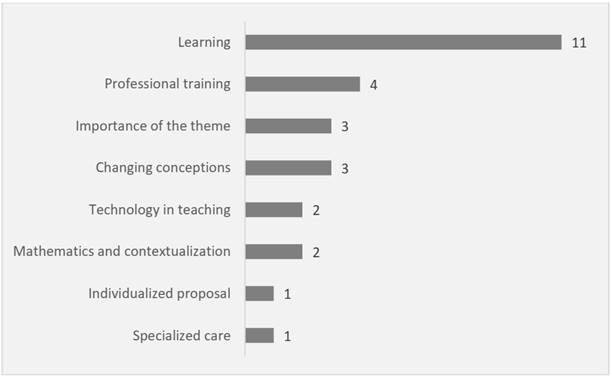
SOURCE: Prepared by the authors.
GRAPH 11: Final categories referring to the main results of the analyzed researches
As Graph 11 shows, the learning of students with CP is the highlight given to the researches analyzed here, followed by professional training and the need for teachers to change their conceptions. For Castorina (1998, p. 26): “It is perfectly defensible that school learning can be conceived as a reconstruction process, taking into account intellectual development.” Associated with this, we perceive the need for teachers to seek alternatives for this learning to materialize.
SOME CONSIDERATIONS
By establishing a general panorama regarding the analyzed studies, one can see characteristics that allow a distinction between Brazilian publications - dissertations - and English-language publications - European or American articles.
One can say there are convergences in the research proposals involving Mathematics Education or Teaching for students with CP. In the analysis of the results achieved by the studies, the articles have the main objective of discussing the learning of the student with CP. The dissertations, in turn, focus on professional training, except D2, which highlights the use of a teaching methodology directly related to the learning in Mathematics.
The inclusion of people with CP in regular classrooms is another point of convergence between the studies analyzed, as can be seen in D1, D3, D4, A3, A4, A7, which place, in most cases, the teacher as an essential factor for inclusion. Another convergence factor refers to the relevance of working memory in the learning process. In these convergences, dissertation D5 mentions this type of memory, as well as articles A2, A3, A4, A5, A7, thus showing the direct relation of the articles with learning.
Thus, one can say there is no emphasis on divergences between the studies, but a characteristic look, with different peculiarities that do not suggest a disagreement between the results obtained. As an example, the author of article A6 proposes a research that differs from the others by not addressing a teaching methodology aimed at groups of typical students and students with CP, but solely at students with CP. In contrast, the authors of article A4 highlight the benefit of the conviviality between typical children and children with CP.
Considering that this proposal of meta-analysis aims to analyze theses, dissertations, or articles on researches made in the area of Mathematics (Education or Teaching) with participation of students with CP, highlighting the participation of these subjects and the way the research proposals were developed, we emphasize, after the conducted searches, the importance of the theme, due to the scarcity of publications found.
Therefore, we conclude that, in the analyzed productions, there is a lack of mutual participation of students with CP and their teachers showing the protagonism of one or the other, without a proposal in which both are active participants. Only one article includes the manifestation of a student with CP. In the dissertations, the manifestation of students with CP occurs in the repercussion of the analysis of research instruments applied during the studies. There is no study, among those analyzed, proposing an interaction between the speeches or opinions of students with CP and their teachers, although the author of a dissertation (D2) uses as participants the teacher, the student with CP, and the respective family, but without an interaction that enables a contribution along with the research.
On the objectives, the English-language articles show approaches that aim to work with the arithmetic development of children. There is a comparison between regular and special schools, valuing the inclusion of students with CP in regular education. However, there are studies in specialized schools as a way of making comparisons. In addition, in the articles, the space given to working memory is very relevant. Regarding working memory, the stimulus is seen as a way for the teacher to consider the limitations of students, not demanding from them the same they may demand from others.
The dissertations - Brazilian publications - focus on teacher training. Not that this aspect is not approached by the articles, but in the dissertations, this is one of the main objectives in the research proposals.
Regarding the methodological procedures, most of the studies was developed by a case study, relying on analysis of interviews, interventions, or application of tests, as stated in some articles. For the conclusions, we highlight as main point the fact that some researches show the possibility of students with CP being able to develop arithmetic reasoning, deconstructing the idea that having a motor problem is associated with having cognitive impairment. Thus, the studies reveal the possibility of developing actions whose proposals consider the fact that, in a regular group of students, some may have physical disabilities and, nonetheless, are able to develop reasoning and learn Mathematics.
For this reason, one of the main characteristics of the researches analyzed is the fact that the articles develop researches related to the learning of students with CP, while most dissertations endeavors to carry out research related to teacher education. Thus, this analysis made it possible to point out that, if these studies had mutually the purpose of contributing to the teacher training process, interacting with the understanding about how students with CP learn, by the protagonism of both participants during the research, then they could collaborate so that the interaction between students and teachers reached a common denominator, which could be the improvement of mathematical learning of students with CP included in regular classrooms.
Finally, we can state that the possibility of teachers reflecting and thinking about a study proposal that has as participants students with CP and their teachers of Mathematics, both contributing with their perspectives and/or experiences so that a proposal can be developed regarding the teaching or learning of Mathematics, would contribute to the academic environment and to improve the learning of all students. We emphasize that the categorization made by this study could have been different if the search took into account other databases, other keywords, and other filters. This is, therefore, a study that requires deepening.
REFERENCES
BELLO, S. E. L. Jogos de Linguagem, práticas discursivas e produção de verdade: contribuições para a educação (matemática) contemporânea. Zetetike-FE, Unicamp, v. 18, n. Temático, p. 545-588, 2010. [ Links ]
BEYER, H. O. Inclusão e Avaliação na escola: de alunos com necessidades educacionais especiais. 2. ed. Porto Alegre: Mediação, 2006. [ Links ]
CASTELLANO, G. B., FREIRE, R. M. A. C. O Diagnóstico Fonoaudiológico na Paralisia Cerebral: O sujeito entre a fala e a escuta. Ágora, Rio de Janeiro, v. XVIII, n. 1, p.117-134, Jan/Jun. 2014. Disponível em: <Disponível em: http://www.scielo.br/scielo.php?script=sci_arttext&pid=S1516-14982014000100008 >. Acesso em: 08 out. 2017. [ Links ]
CASTORINA, J. A. et al. Piaget - Vygotsky: Novas contribuições para o debate. 5. ed. São Paulo: Ática, 1998, p.7-50. [ Links ]
CASTRO, A. A. Revisão sistemática e meta-análise. 2001. Disponível em: <Disponível em: http://www.usinadepesquisa.com/metodologia/wp-content/uploads/2010/08/meta1.pdf > Acesso em: 01 jun. 2018. [ Links ]
CHIESA, A. P. Desenvolvimento de competências numéricas e inclusão escolar: uma pesquisa de intervenção com um adolescente com paralisia cerebral. Dissertação (Mestrado em processos de desenvolvimento humano e saúde). Instituição de ensino: Universidade de Brasília, 2015. Disponível em: < Disponível em: http://repositorio.unb.br/handle/10482/19372 >. Acesso em: 23 abr.2018. [ Links ]
COSENZA, R. M; GUERRA, L. B. Neurociência e Educação: como o cérebro aprende. Porto Alegre: Artmed, 2011. [ Links ]
COSTA, M. A. F. da. COSTA, M, F. B. Metodologia da Pesquisa: Conceitos e técnicas. Rio de Janeiro: Interciência, 2001. [ Links ]
D’AMBROSIO, U. Educação para uma sociedade em transição. Campinas: Papirus, 1999. [ Links ]
D’AMBROSIO, U. Transdisciplinaridade. São Paulo: Palas Athena, 1997. [ Links ]
FELBERG, S. C. F. Desempenho matemático e lesão cerebral: contradizendo explicações simplistas. Dissertação (Mestrado em Educação: Psicologia da Educação). Pontifícia Universidade Católica de São Paulo, São Paulo, 2010. Disponível em:<Disponível em:https://tede2.pucsp.br/handle/handle/15971 >. Acesso em: 23 abr. 2018. [ Links ]
FIORENTINI, D. Pesquisar práticas colaborativas ou pesquisar colaborativamente? In: BORBA, Marcelo de C. ARAÚJO, Jussara de L. (org). Pesquisas qualitativas em Educação Matemática. 5. Ed. Belo Horizonte: Autêntica. 2013. p.53-86. [ Links ]
GARNICA, A. V. M. Filosofia da Educação Matemática: algumas ressignificações e uma proposta de pesquisa. In: BICUDO, M. A. V. (org.); Pesquisa em Educação Matemática: Concepções e perspectivas. São Paulo: Editora UNESP, 1999. p. 59-74. [ Links ]
HOFFMANN, R. TAFNER, M. FISCHER, J. Paralisia Cerebral e aprendizagem: Um estudo de caso inserido no ensino regular. Revista Leonardo pós órgão de divulgação científica e cultural, v. 1, 2003. [ Links ]
IMBERNÓN, F. Formação Docente e Profissional: Formar-se para a mudança e a incerteza. São Paulo: Cortez, 2000. [ Links ]
JENKS , K. M. et al. The Effect of Cerebral Palsy on Arithmetic Accuracy is Mediated by Working Memory, Intelligence, Early Numeracy, and Instruction Time. Developmental Neuropsychology, London, V.32, n.3, p.861-879, 2007. Disponível em: <Disponível em: http://dx.doi.org/10.1080/87565640701539758 >. Acesso em: 20 maio. 2018. [ Links ]
JENKS, K. M. MOOR, J. LIESHOUT, E.C.D.M. Arithmetic difficulties in children with cerebral palsy are related to executive function and working memory. Journal of Child Psychology and Psychiatry, Bethesda, v.50, n.7, p. 824-833, 2009. Disponível em: <Disponível em: https://onlinelibrary.wiley.com/doi/abs/10.1111/j.1469-7610.2008.02031.x >. Acesso em: 11 mai. 2018. [ Links ]
LIMA, V.M.R.; HARRES, J.B.S; PAULA, M. C. Caminhos da pesquisa qualitativa no campo da educação em ciências: pressupostos, abordagens e possibilidades. Porto Alegre: EDIPUCRS, 2018. [ Links ]
MAGNE, O. Mathematics and quality of life. A new theme in special teacher education. Didakometry (Malmo, Sweden: School of Edu-cation), Durbanville, n. 75, mar. 1994. Disponível em: <Disponível em: https://www.uu.nl/file/58621/download?token=5Vk-DVV1 >. Acesso em: 10 mai. 2018. [ Links ]
MANTOAN, M.T.E. A integração de pessoas com deficiência: Contribuições para uma reflexão sobre o tema. São Paulo: Memnon, 1997. [ Links ]
MANTOAN, M. T. E; PIETRO, R. G; ARANTES, V. A. Inclusão Escolar. São Paulo: Summus, 2006. [ Links ]
MELO, F. R. L. V, MARTINS, L. A. R. O que pensa a comunidade escolar sobre o aluno com paralisia cerebral. Revista Brasileira de Educação Especial, Marília, v. 10, n. 1, p. 75-92, Jan/Abr.2004. Disponível em: <Disponível em: http://www.scielo.br/scielo.php?script=sci_arttext&pid=S1413-65382007000100008 >. Acesso em: 08 out. 2017. [ Links ]
MITTLER, P. Educação Inclusiva: Contextos Sociais. Porto Alegre: Artmed, 2003. [ Links ]
MORAES, R; GALIAZZI, M. C. Análise Textual Discursiva. 2. ed. Ijuí: Unijuí, 2014. [ Links ]
OLIVEIRA, S. L. Tratado de Metodologia Científica. 2. ed.São Paulo: Ed.Pioneira, 1999. [ Links ]
POLETTINI, A. F. F. Análise das experiências vividas determinando o desenvolvimento profissional do professor de matemática. In: BICUDO, Maria aparecida V. (org.); Pesquisa em Educação Matemática: Concepções e perspectivas. São Paulo: Editora UNESP, 1999. p.247-261. [ Links ]
ROOIJEN, M. V. et al. Arithmetic performance of children with cerebral palsy: The influence of cognitive and motor factors. Research in Developmental Disabilities. Toulouse, v. 33, n.2, p. 530-537, mar.- abr. 2012. Disponível em: <Disponível em: https://www.academia.edu/6155545/Arithmetic_performance_of_children_with_cerebral_palsy_The_influence_of_cognitive_and_motor_factors >. Acesso em: 10 mai. 2018. [ Links ]
ROOIJEN, M. V; VERHOEVEN, L; STEENBERGEN, B. Early numeracy in cerebral palsy: review and future research. U.S.U.s. National Library of Medicine, Bethesda, p. 202-209, 2010. Disponível em: <Disponível em: https://www.ncbi.nlm.nih.gov/pubmed/21087241 >. Acesso em: 20 maio. 2018. [ Links ]
ROTTA, N. T. Paralisia Cerebral: Novas Perspectivas Terapêuticas. Jornal de Pediatria, Rio de Janeiro, v. 78, n. 1, p.48-54, 2002. Disponível em: <Disponível em: http://www.scielo.br/pdf/jped/v78s1/v78n7a08.pdf >. Acesso em: 08 out. 2017. [ Links ]
SANTANA, R. S. Ressignificação da prática pedagógica: aprendizagem do número numa perspectiva inclusiva. Dissertação (Mestrado em Educação). Faculdade de Educação: Universidade de Brasília, 2010. Disponível em: <Disponível em: http://repositorio.unb.br/handle/10482/9109 >. Acesso em:11 maio. 2018. [ Links ]
SHAW, K. L; DURDEN, P. Learning How Amanda, a High School Cerebral Palsy Student, Understands Angles. Wiley Online Library: School Science and Mathematics, Florida, v.98, n.4, p.198-204, 1998. Disponível em: <Disponível em: https://doi.org/10.1111/j.1949-8594.1998.tb17416.x >. Acesso em: 20 maio. 2018. [ Links ]
SHEEHEY, P. H; WELLS, J. C; ROWE, M. Effects of self-monitoring on math competency of an elementary student with cerebral palsy in an inclusive classroom. Preventing School Failure, Manoa, p.211-219, dez.2016. Disponível em: <Disponível em: https://www.tandfonline.com/doi/abs/10.1080/1045988X.2016.1261268 >. Acesso em: 11 mai. 2018. [ Links ]
SILVA, T. T. da; HALL, S; WOODWARD, K. Identidade e Diferença: A perspectiva dos estudos culturais. 15. ed.Petrópolis: Vozes, 2014. [ Links ]
SILVA, L. L. O jogo de bocha adaptado como recurso no ensino da matemática para alunos com paralisia cerebral. Dissertação (Programa de Pós-Graduação Profissional em Ensino de Ciências Exatas) . Instituição de ensino: Centro Universitário UNIVATES, Lajeado, 2014. Disponível em: Disponível em: http://HDL.handle.net/10737/599 . Acesso em:23 abr.2018. [ Links ]
TOSTES, A. M. B. Matemática Inclusiva, Situações Didáticas e Tecnologia: Um estudo de caso no ensino superior. Dissertação (Mestrado Profissional em Educação Matemática). Universidade Severino Sombra, Vassouras-RJ, 2013. Disponível em: <Disponível em: https://sucupira.capes.gov.br/sucupira/public/consultas/coleta/trabalhoConclusao/viewTrabalhoConclusao.jsf?popup=true&id_trabalho=540423# >. Acesso em: 18 maio. 2018. [ Links ]
1Information found in: TUTORIAL BANCO DE TESES DA CAPES. Available in: <https://www.google.com/url?sa=t&source=web&rct=j&url=http://www.arq.ufmg.br/bib/wp-content/uploads/2014/03/Tutorial-Banco-Teses-da-CAPES.docx&ved=2ahUKEwiNy-fs9ZbhAhXdGbkGHQDhAgIQFjAAegQIBRAB&usg=AOvVaw2fvRykJqY-FDTho8u7prqV> Access in: 22 de mar. for 2018.
Received: October 24, 2018; Accepted: June 10, 2019











 texto em
texto em 


